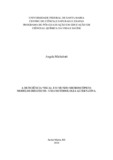| dc.creator | Michelotti, Angela | |
| dc.date.accessioned | 2018-12-05T19:33:35Z | |
| dc.date.available | 2018-12-05T19:33:35Z | |
| dc.date.issued | 2018-02-23 | |
| dc.identifier.uri | http://repositorio.ufsm.br/handle/1/15037 | |
| dc.description.abstract | The use of didactic models in Science teaching becomes a didactic alternative to integrate students with Visual Deficiency into regular classes. With the use of cell didactic models we are able to bring the microscopic world for Seers and non-Seers students. The objective of this research was to test the hypothesis if alternative methodological activities, through the use of Didactic Models, can help Seers and Visual Deficits students in learning basic Cytology concepts. The total number of participants was: 23 seers students and 5 students with visual impairment (3 blind, and 2 with low vision), of 8th and 9th grade, elementary school. The research took place in 5 moments: a) pretest, b) tactile perception activity, c) researcher intervention, d) posttest I and e) posttest II - interview after 5 months. The results are presented in two manuscripts. In the first manuscript, attend to he question about the coexistence in the classroom, of seers and non-seerns colleagues, seers and Visual Impairments and about the teaching and learning of Sciences. It was noticeable that inclusion benefits both the student with Visual Impairments and the student without Disabilities in the matter of their personal growth, and in the interaction with their colleagues. It is in the school environment that students are faced with diversity, they realize that each has its individuality and uniqueness. The second manuscript address the use of didactic models as alternative methodologies for the teaching of the following cytology concepts: cellular forms, cellular multiplication process and skin cicatrization. The results showed that the students obtained a greater understanding with the use of the presented methodology, being able to be perceived in their answers greater clarity and objectivity, after the accomplishment of the activities. The use of three-dimensional models designed to be felt and visualized, contributes to the inclusion of the Visually Impaired student, together with the sighted student. The sighted students were able to use another meaning, in addition to the vision to first "see" the cells, experiencing some of the difficulties encountered by their colleagues. | eng |
| dc.description.sponsorship | Coordenação de Aperfeiçoamento de Pessoal de Nível Superior - CAPES | por |
| dc.language | por | por |
| dc.publisher | Universidade Federal de Santa Maria | por |
| dc.rights | Attribution-NonCommercial-NoDerivatives 4.0 International | * |
| dc.rights.uri | http://creativecommons.org/licenses/by-nc-nd/4.0/ | * |
| dc.subject | Deficiência visual | por |
| dc.subject | Modelos didáticos | por |
| dc.subject | Mundo microscópico | por |
| dc.subject | Inclusão | por |
| dc.subject | Visual deficiency | eng |
| dc.subject | DidacticModels | eng |
| dc.subject | Microscopic world | eng |
| dc.subject | Inclusion | eng |
| dc.title | A deficiência visual e o mundo microscópico: modelos didáticos - uma metodologia alternativa | por |
| dc.title.alternative | Visual deficiency and the microscopic world: didactic models - an alternative methodology | eng |
| dc.type | Dissertação | por |
| dc.description.resumo | A utilização de modelos didáticos no ensino de Ciências torna-se uma alternativa didática para integrar alunos com Deficiência Visual em classes regulares. Com a utilização de modelos didáticos celulares, conseguimos abordar o mundo microscópico para alunos videntes e para os não videntes. O objetivo da pesquisa foi testar a hipótese se as atividades metodológicas alternativas, através do uso de modelos didáticos no ensino de célula, podem auxiliar alunos videntes e com Deficiência Visual no aprendizado de conceitos básicos de Biologia Celular. O total de alunos participantes foram: 23 alunos videntes e cinco alunos com Deficiência Visual (três cegos e dois com baixa visão), de 8º e 9º ano, do ensino fundamental. A pesquisa ocorreu em cinco momentos: a) pré teste, b) atividade de percepção tátil, c) intervenção do pesquisador,
d) pós-teste I e e) pós-teste II - entrevista após cinco meses. Os resultados encontram-se em dois manuscritos. O primeiro manuscrito aborda questionamentos referentes à convivência em sala de aula com os colegas videntes e com Deficiência Visual e sobre o ensino e a aprendizagem de Ciências. Foi perceptível nas falas dos alunos que a inclusão beneficia tanto o aluno com Deficiências Visual quanto o aluno sem deficiência na questão do seu crescimento pessoal e na interação com os colegas. É no ambiente escolar que os alunos deparam-se com a diversidade, eles perceberam que cada um tem a sua individualidade e singularidade. O segundo manuscrito abordou a utilização dos modelos didáticos como metodologias alternativas para o ensino dos seguintes conceitos de Biologia Celular: formas celulares, processo de multiplicação celular e cicatrização da pele. Os resultados demonstraram que os alunos obtiveram um maior entendimento com o uso da metodologia apresentada, podendo ser percebido, nas suas respostas, maior clareza e objetividade, após a realização das atividades. A utilização de modelos tridimensionais elaborados de forma a serem tateados e visualizados contribui para a inclusão do aluno com Deficiência Visual, juntamente com o aluno vidente. Os alunos videntes puderam utilizar outro sentido, além da visão, para, em primeiro momento, “ver” as células, vivenciando um pouco das dificuldades encontradas por seus colegas. | por |
| dc.contributor.advisor1 | Loreto, Elgion Lucio da Silva | |
| dc.contributor.advisor1Lattes | http://lattes.cnpq.br/6493669115018157 | por |
| dc.contributor.referee1 | Pessano, Edward Frederico Castro | |
| dc.contributor.referee1Lattes | http://lattes.cnpq.br/2760002240063004 | por |
| dc.contributor.referee2 | Pereira, Josefa Lídia Costa | |
| dc.contributor.referee2Lattes | http://lattes.cnpq.br/0621869920121540 | por |
| dc.creator.Lattes | http://lattes.cnpq.br/6513790493603208 | por |
| dc.publisher.country | Brasil | por |
| dc.publisher.department | Bioquímica | por |
| dc.publisher.initials | UFSM | por |
| dc.publisher.program | Programa de Pós-Graduação em Educação em Ciências: Química da Vida e Saúde | por |
| dc.subject.cnpq | CNPQ::CIENCIAS BIOLOGICAS::BIOQUIMICA | por |
| dc.publisher.unidade | Centro de Ciências Naturais e Exatas | por |



